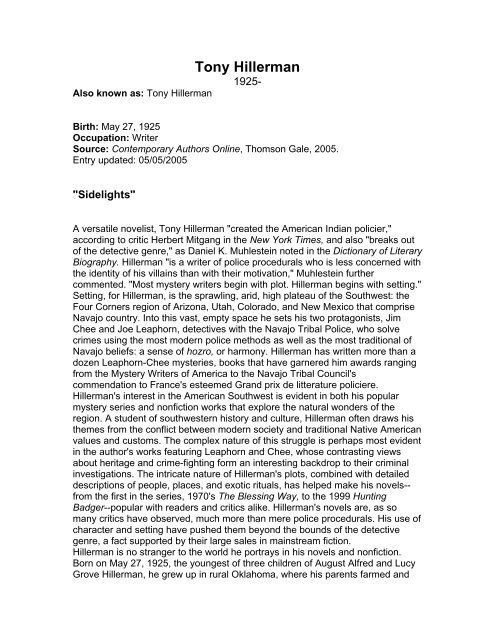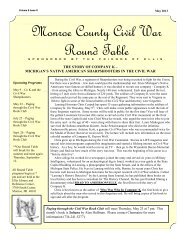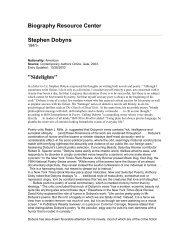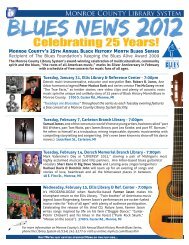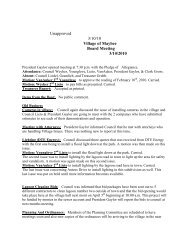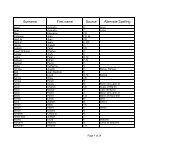Tony Hillerman Bio.pdf
Tony Hillerman Bio.pdf
Tony Hillerman Bio.pdf
Create successful ePaper yourself
Turn your PDF publications into a flip-book with our unique Google optimized e-Paper software.
<strong>Tony</strong> <strong>Hillerman</strong><br />
1925-<br />
Also known as: <strong>Tony</strong> <strong>Hillerman</strong><br />
Birth: May 27, 1925<br />
Occupation: Writer<br />
Source: Contemporary Authors Online, Thomson Gale, 2005.<br />
Entry updated: 05/05/2005<br />
"Sidelights"<br />
A versatile novelist, <strong>Tony</strong> <strong>Hillerman</strong> "created the American Indian policier,"<br />
according to critic Herbert Mitgang in the New York Times, and also "breaks out<br />
of the detective genre," as Daniel K. Muhlestein noted in the Dictionary of Literary<br />
<strong>Bio</strong>graphy. <strong>Hillerman</strong> "is a writer of police procedurals who is less concerned with<br />
the identity of his villains than with their motivation," Muhlestein further<br />
commented. "Most mystery writers begin with plot. <strong>Hillerman</strong> begins with setting."<br />
Setting, for <strong>Hillerman</strong>, is the sprawling, arid, high plateau of the Southwest: the<br />
Four Corners region of Arizona, Utah, Colorado, and New Mexico that comprise<br />
Navajo country. Into this vast, empty space he sets his two protagonists, Jim<br />
Chee and Joe Leaphorn, detectives with the Navajo Tribal Police, who solve<br />
crimes using the most modern police methods as well as the most traditional of<br />
Navajo beliefs: a sense of hozro, or harmony. <strong>Hillerman</strong> has written more than a<br />
dozen Leaphorn-Chee mysteries, books that have garnered him awards ranging<br />
from the Mystery Writers of America to the Navajo Tribal Council's<br />
commendation to France's esteemed Grand prix de litterature policiere.<br />
<strong>Hillerman</strong>'s interest in the American Southwest is evident in both his popular<br />
mystery series and nonfiction works that explore the natural wonders of the<br />
region. A student of southwestern history and culture, <strong>Hillerman</strong> often draws his<br />
themes from the conflict between modern society and traditional Native American<br />
values and customs. The complex nature of this struggle is perhaps most evident<br />
in the author's works featuring Leaphorn and Chee, whose contrasting views<br />
about heritage and crime-fighting form an interesting backdrop to their criminal<br />
investigations. The intricate nature of <strong>Hillerman</strong>'s plots, combined with detailed<br />
descriptions of people, places, and exotic rituals, has helped make his novels-from<br />
the first in the series, 1970's The Blessing Way, to the 1999 Hunting<br />
Badger--popular with readers and critics alike. <strong>Hillerman</strong>'s novels are, as so<br />
many critics have observed, much more than mere police procedurals. His use of<br />
character and setting have pushed them beyond the bounds of the detective<br />
genre, a fact supported by their large sales in mainstream fiction.<br />
<strong>Hillerman</strong> is no stranger to the world he portrays in his novels and nonfiction.<br />
Born on May 27, 1925, the youngest of three children of August Alfred and Lucy<br />
Grove <strong>Hillerman</strong>, he grew up in rural Oklahoma, where his parents farmed and
an a local store. <strong>Hillerman</strong> loved reading and books as a youth, and in those<br />
days before television and without even enough money for batteries for the radio,<br />
he also formed an appreciation for oral storytelling. He would listen to the men<br />
who gathered at his parents' store to tell stories and tall tales, and learned<br />
pacing, timing, and the importance of detail. <strong>Hillerman</strong>'s youth was thus spent, as<br />
Muhlestein noted, "poor in money but rich in the tools of a future writer."<br />
<strong>Hillerman</strong> also learned, according to Muhlestein, "what it meant to be an<br />
outsider," by attending a boarding school for Potawatomie Indian girls. Doubly<br />
removed because of both race and gender, <strong>Hillerman</strong> internalized this feeling of<br />
being an outsider, but also formed a deep and abiding respect for Indian ways<br />
and culture. As important as that message was, he also learned another: the<br />
significance of class in America. As a youngster <strong>Hillerman</strong> viewed himself as a<br />
country boy, one who got his haircuts at home, not at a barber shop. If the world<br />
were divided into urban and rural, he would opt for the latter.<br />
After graduating from high school, <strong>Hillerman</strong> began college at Oklahoma State<br />
University, but then joined the army to fight in World War II. He took part in the D-<br />
Day landings, was wounded in Alsace, and earned a Silver Star, among other<br />
decorations. His letters home, which found their way into the hands of a<br />
journalist, were so detailed and spirited that the newspaperman convinced the<br />
young returning soldier to take up a career in writing.<br />
Enrolling in journalism courses, <strong>Hillerman</strong> also worked part-time to support his<br />
education. It was in 1945, while driving a truckload of drilling pipe from Oklahoma<br />
to New Mexico, that he first encountered the Navajo and their reservation. The<br />
Navajos he first saw were engaged in a curing ceremony called the Enemy Way,<br />
during which a young Navajo fresh from service in the war, like <strong>Hillerman</strong> himself,<br />
was being cured of the foreign contamination and brought back into harmony<br />
with his own people. "When I met the Navajos I now so often write about,"<br />
<strong>Hillerman</strong> recalled to Ernie Bulow in Talking Mysteries, "I recognized kindred<br />
spirits. Country boys. More of us. Folks among whom I felt at ease." In 1948,<br />
<strong>Hillerman</strong> graduated from the journalism program at the University of Oklahoma.<br />
He was also married that year to Marie Unzner; the couple would eventually have<br />
one child together and adopt five additional children.<br />
<strong>Hillerman</strong> took several newspaper jobs in and around Oklahoma, Texas, and<br />
New Mexico before joining the staff of the Santa Fe New Mexican in 1954. He<br />
stayed with that paper until 1963, working at the end of his journalism career as<br />
executive editor. But he had a longing to become a novelist, and with the<br />
encouragement of his wife, left journalism behind to study writing, soon becoming<br />
a journalism professor at the University of New Mexico, where he remained until<br />
1985. It was while he was a professor of journalism that he wrote his first novel,<br />
The Blessing Way, in which he introduces Joe Leaphorn, a fiftyish Navajo with<br />
the Tribal Police on the reservation. Leaphorn, however, was almost cut out of<br />
this manuscript at the urging of <strong>Hillerman</strong>'s agent. Finally, an editor at Harper &<br />
Row wrote an enthusiastic critique of the manuscript, wanting <strong>Hillerman</strong> to<br />
increase Leaphorn's role, and the writer's first major protagonist was born.<br />
In this debut novel, the motive for the murder of a young Navajo is witchcraft in<br />
the shape of a Navajo Wolf, akin to a werewolf. According to Geoff Sadler, a
contributor for Contemporary Popular Writers, this novel "is a tense, exciting<br />
adventure that mixes espionage with witchcraft." <strong>Hillerman</strong>'s second novel, Fly<br />
on the Wall, is a story of political corruption with a journalist serving as the chief<br />
investigator. Returning with his third novel to Navajo country, as he has remained<br />
with all but one more of his novels, <strong>Hillerman</strong> next sent his reserved, logical, and<br />
partially assimilated detective, Leaphorn, into Zuni country to investigate tribal<br />
rites in The Dance Hall of the Dead. This second "Leaphorn" novel, which earned<br />
its author the Edgar Allan Poe Award from the Mystery Writers of America,<br />
begins with the murder of Ernesto Cata, a Zuni boy who is in training for an<br />
important ceremonial role in his tribe. Suspicion falls on a Navajo boy, George<br />
Bowlegs, but when Bowlegs is in turn murdered, Leaphorn follows clues and his<br />
instinct to a white archaeologist who killed the boys to keep them from disclosing<br />
that he had been fudging finds at his excavation site. <strong>Hillerman</strong>'s third "Leaphorn"<br />
novel, Listening Woman, finds the Navajo detective investigating two homicides<br />
and becoming trapped in an underground cavern with terrorists and their<br />
hostages. "The novel combines clever plotlines with sharp character insights and<br />
a taut, nail-biting payoff," wrote Sadler.<br />
With People of Darkness <strong>Hillerman</strong> introduces a second major protagonist, Jim<br />
Chee, who, like Leaphorn, is a Navajo tribal officer, but who, unlike Leaphorn is<br />
more traditional, less experienced, younger, and more in flux. One major reason<br />
for creating Chee was that <strong>Hillerman</strong> had sold the television rights for his<br />
Leaphorn character; he also knew he needed a different kind of protagonist,<br />
someone younger and less sophisticated than Leaphorn. In this story, Chee, a<br />
part-time ceremonial singer who is also drawn to the white lifestyle and the<br />
possibility of a career in the FBI, investigates a burglary at a wealthy white man's<br />
house which leads to a thirty-year-old crime aboard an oil rig. Chee's second<br />
adventure, The Dark Wind, has the younger Navajo detective chasing criminals<br />
involved in a cocaine ring who have killed several Navajos. In The Ghostway,<br />
Chee is off to Los Angeles in pursuit of two Navajos who are stealing luxury cars.<br />
But when the thieves return to the reservation, one of them is killed in his uncle's<br />
hogan (dwelling). Chee's heritage comes to the fore when he discovers that<br />
whoever laid the young man out for burial neglected one of the ceremonies and<br />
was thus not really a Navajo. Such a connection with tradition might come in<br />
handy in Chee's work, but not in his love life, for it isolates him from his white<br />
schoolteacher lover who ultimately leaves the reservation. Reviewing The<br />
Ghostway in Entertainment Weekly, a contributor noted that you don't have to be<br />
"a regular at Tribal Policeman Jim Chee's pow-wows to dig The Ghostway, one<br />
of the freshest of <strong>Hillerman</strong>'s whodunits."<br />
After finishing The Ghostway, <strong>Hillerman</strong> bought back the rights to Joe Leaphorn,<br />
and in his next novel, Skinwalkers, he pairs the detective with Chee, as he has<br />
continued to do in succeeding titles. The two investigators act as foils to one<br />
another: Leaphorn the older, more mature and methodical detective, and Chee<br />
the more quixotic, impulsive loner. The Skinwalkers of the title are Navajo ghosts,<br />
and the novel, which starts out with a shotgun attack on Chee, has witchcraft at<br />
its very heart. Leaphorn helps the younger detective get to the bottom of this<br />
attack and others on the reservation. A Golden Spur Award winner, Skinwalkers
is a "strong, neatly worked novel with a shocking climax," according to Sadler.<br />
Writing in People, Campbell Geeslin noted that <strong>Hillerman</strong> "packs his novels with<br />
compelling details of Navajo life and beautiful descriptive passages about the<br />
land and weather." Geeslin concluded, "Chee . . . is a perfect guide through<br />
<strong>Hillerman</strong>'s effective, dreamlike world."<br />
Skinwalkers was, according to Michael Neill in People, <strong>Hillerman</strong>'s "commercial<br />
breakthrough," selling 40,000 copies in hardcover and 100,000 in paperback. Yet<br />
it was his next title, A Thief of Time, that secured him a place on the best-seller<br />
charts and propelled <strong>Hillerman</strong> to national attention. Beginning with a murder at<br />
an Anasazi historical site, the book features a psychopathic killer and more<br />
development of the relationship between Leaphorn and Chee. In this novel,<br />
Leaphorn has to cope with his wife's death as well as his own impending<br />
retirement. As <strong>Hillerman</strong>'s main recurring characters, Leaphorn and Chee serve a<br />
dual function. On one level, the officers act as guides into a world of traditions<br />
and customs unfamiliar to most readers; on another level, <strong>Hillerman</strong>'s depiction<br />
of Leaphorn and Chee's day-to-day struggles--with bureaucratic red tape,<br />
discrimination, and intimate relationships--helps readers understand the difficulty<br />
of living in what amounts to two worlds with different, and often contradictory,<br />
sets of rules.<br />
This culture clash is not always depicted in a negative light, however. In books<br />
such as Listening Woman and The Ghostway, Leaphorn and Chee use both<br />
standard police procedures and their special knowledge of tribal customs to solve<br />
a wide variety of baffling crimes. In Listening Woman, Leaphorn finds clues to a<br />
double murder in a group of ritual sand paintings. An oddly-performed death<br />
ceremony puts Chee on the trail of a missing girl and a killer in The Ghostway.<br />
Stolen pottery from a "lost" tribe becomes the focus of Leaphorn's investigation<br />
into artifact trafficking in A Thief of Time, a book that is at once "careful with the<br />
facts," and one that "transmutes knowledge into romance," as a contributor to<br />
Time magazine wrote. Karl G. Fredrikkson and Lilian Fredrikkson called A Thief<br />
of Time "probably <strong>Hillerman</strong>'s best novel," in the St. James Guide to Crime and<br />
Mystery Writers, and they further noted, "History and tradition play integral parts<br />
in all <strong>Hillerman</strong>'s novels and especially in this one." The Fredrikksons concluded<br />
that the main theme of all <strong>Hillerman</strong>'s work "is the clash between the Navajo Way<br />
and the so-called American Way of Life, between tradition and the emptiness of<br />
modern society."<br />
As with Dance Hall of the Dead and A Thief of Time, <strong>Hillerman</strong>'s novel Talking<br />
God deals with anthropology. This time, both Chee and Leaphorn desert the<br />
reservation for Washington, D.C., in search of missing Native American artifacts.<br />
"The plot," noted Louise Bernikow in a Cosmopolitan review, "comes to a<br />
crashing finale in the Smithsonian Institute, and the evil that has disturbed the<br />
spirits of the Navajo is laid to rest." Bernikow also commented that <strong>Hillerman</strong>'s<br />
story "is complicated, emotional, and incredibly suspenseful." In Coyote Waits,<br />
an officer in the Navajo Tribal Police, Delbert Nez, is gunned down, and<br />
Leaphorn and Chee set out to find his killer. It looks as if a Navajo shaman might<br />
be responsible for the killing, until other suspects turn up, including a Vietnamese<br />
teacher. Behind it all lurks the mythic Navajo character representing chaos, the
Coyote of the title. Phoebe-Lou Adams, writing in the Atlantic, felt the plot "is a<br />
humdinger even by the high <strong>Hillerman</strong> standard," while a writer for Entertainment<br />
Weekly dubbed it "sturdy work from an incorruptible craftsman." Reviewing the<br />
title in People, Neill concluded, "<strong>Hillerman</strong>'s elevation into the best-seller ranks is<br />
a great justice of American popular writing. While his novels are mysteries, they<br />
are also exquisite explorations of human nature--with a great backdrop."<br />
Reviewing Coyote Waits, a contributor for Publishers Weekly commented,<br />
"<strong>Hillerman</strong> weaves an understated, powerful tale from strands of ancient Navajo<br />
mythology, modern greed and ambition, and above all, the sorrows and delights<br />
of characters."<br />
In Sacred Clowns, the duo investigate the seemingly unrelated murders of a<br />
shop teacher at the mission school and a sacred clown dancer, a Hopi koshare.<br />
In this novel, Chee is increasingly attracted to the Navajo lawyer, Janet Pete,<br />
while Leaphorn considers a relationship with a linguistics professor. "Telling his<br />
story the Navajo way," wrote a contributor to Publishers Weekly, "<strong>Hillerman</strong> fully<br />
develops the background of the cases . . . so that the resolutions . . . ring true<br />
with gratifying inevitability." Gene Lyons, writing in Entertainment Weekly, noted<br />
that even "devoted readers . . . will find Sacred Clowns just a bit different from<br />
earlier books in the series." Lyons pointed to the essentially "comic" structure and<br />
tone of the novel.<br />
One interesting aspect of <strong>Hillerman</strong>'s novels is that his protagonists have not<br />
stayed rooted in time, but rather have developed and aged: Leaphorn has retired,<br />
yet keeps a hand in police affairs, while Chee begins to settle down. The pair<br />
took a hiatus in the mid-1990s while <strong>Hillerman</strong> turned his hand to various other<br />
projects, including The Mysterious West and another novel set in Vietnam,<br />
Finding Moon. Then in 1997, the duo returned with The Fallen Man. In this novel,<br />
mountaineers find a skeleton near the summit of Ship Rock in northwestern New<br />
Mexico. The skeleton in question turns out to be that of a member of a local white<br />
family who disappeared eleven years earlier. Leaphorn, who remembers the<br />
earlier disappearance, comes back into action, though Chee, now a lieutenant, at<br />
first bristles at his intrusion. Meantime also the romance between Chee and<br />
ambitious attorney Janet Pete, whom he is courting, takes twists and turns... "As<br />
always," noted a reviewer for Publishers Weekly, "<strong>Hillerman</strong> treats Indian<br />
tradition and modern troubles . . . with unsentimental respect, firmly rooting his<br />
mystery in the region's distinctive peoples and geography." Sikki Andur, writing in<br />
Entertainment Weekly, called this thirteenth novel "a scenic ride through a land<br />
where police are more worried about cattle rustling than dope dealing," and<br />
where "a cop who's been shot doesn't crave revenge--he wants harmony."<br />
Booklist reviewer Stephanie Zvirin commented, "As usual, <strong>Hillerman</strong> masterfully<br />
sets the scene, conveying contemporary culture and weaving in intriguing side<br />
plots to add depth to character and scene." Zvirin concluded that "with all<br />
<strong>Hillerman</strong>'s stories, it's the oblique way" of getting to the end "that pulls [the<br />
reader] along."<br />
The First Eagle, published in 1998, features another scientist who comes from<br />
outside to the "res," a theme found in several of <strong>Hillerman</strong>'s books. This time it is<br />
a missing female biologist who has been tracking the Bubonic plague in the
prairie dogs of the Southwest. Leaphorn is hired by the scientist's grandmother to<br />
find her; meanwhile Chee is investigating the bludgeon death of a Navajo Police<br />
officer at the site where the biologist was last seen. "<strong>Hillerman</strong>'s trademark<br />
melding of Navajo tradition and modern culture is captured with crystal clarity in<br />
this tale of an ancient scourge's resurgence in today's word," noted a reviewer for<br />
Publishers Weekly. Booklist's Zvirin felt that "<strong>Hillerman</strong>'s respect and deep<br />
affection for his creations and their community" runs through all of the subplots<br />
and twists of action. Hunting Badger, published in 1999, was inspired by an<br />
actual manhunt in the Four Corners region in which the search for the killers was<br />
badly bungled by the FBI. In <strong>Hillerman</strong>'s scenario, there is a robbery at an Ute<br />
casino, and the security officer there is killed in the process. Chee is drawn into<br />
the case along with Leaphorn. Reviews of this fifteenth book in the series were<br />
somewhat mixed. Wilda Williams, writing in Library Journal, felt that the novel<br />
"offers a paint-by-the-numbers plot with cardboard characters," but that "diehard<br />
fans will want this." However a reviewer for Publishers Weekly wrote that<br />
"<strong>Hillerman</strong> is in top form" with Hunting Badger, and Booklist's Bill Ott dubbed<br />
Hunting Badger "a return to form for <strong>Hillerman</strong>." Ott concluded, "Nobody uses the<br />
power of myth to enrich crime fiction more effectively than <strong>Hillerman</strong>."<br />
In The Sinister Pig readers are provided with "an intricate pattern of ingenious<br />
detective work, comic romance, tribal custom, and desert atmosphere" which<br />
provide "multifaceted reading pleasure" according to reviewer Connie Fletcher of<br />
Booklist. The novel once again follows <strong>Hillerman</strong>'s usual cast of characters as<br />
they try to solve a mystery involving a body discovered on Navajo land and its<br />
connection to billions of dollars owed to the Native Americans as oil royalties.<br />
Christine C. Menefee, reviewing the novel for School Library Journal, stated that<br />
readers "should enjoy the broader geographical and social canvas . . . in this tale<br />
of ordinary people unraveling knots of fraud and skullduggery."<br />
<strong>Hillerman</strong> has also been commended for his nonfiction works and for anthologies<br />
that explore the natural beauty and unique history of the Southwest. In New<br />
Mexico, Rio Grande, and Other Essays, the author discusses a number of topics,<br />
including how geographical, political, and historical factors helped the Pueblo<br />
Indians thrive when many other tribes fell prey to conquering forces. In The<br />
Mysterious West, <strong>Hillerman</strong> as editor pulls together previously unpublished<br />
stories from writers such as J. A. Jance and Marcia Muller, while in The Oxford<br />
Book of American Detective Stories and The Best American Stories of the<br />
Century he shows his ties to the mystery genre are as strong as those to the<br />
Southwest. But in the final analysis, <strong>Hillerman</strong> is known for his Chee-Leaphorn<br />
books and their evocation of Navajo country. In these books, the author explores,<br />
as Muhlestein noted in Dictionary of Literary <strong>Bio</strong>graphy, "the themes he cares<br />
about most deeply: the question of identity, the tension between the desire to<br />
assimilate and the need to retain native traditions, the shortcomings of Anglo<br />
justice, and the spiritual illness of white culture." As Fred Erisman commented in<br />
<strong>Tony</strong> <strong>Hillerman</strong>, "Leaphorn and Chee, as Navajos, give readers a sense of the<br />
demands of Southwestern life. In a larger sense, though, that they are Navajo is<br />
incidental; they are human as well as Navajo, and as they . . . grapple with the<br />
realities of their people, their place, and their time, their responsibilities help all
eaders to decipher the palimpsest of human life in all its complexity and all its<br />
majesty."<br />
PERSONAL INFORMATION<br />
Born May 27, 1925; son of August Alfred (a farmer) and Lucy (Grove) <strong>Hillerman</strong>;<br />
married Marie Unzner, August 16, 1948; children: Anne, Janet, Anthony, Monica,<br />
Stephen, Daniel. Education: Attended Oklahoma State University, 1943;<br />
University of Oklahoma, B.A., 1946; University of New Mexico, M.A., 1966.<br />
Politics: Democrat Religion: Roman Catholic Avocational Interests: Trout<br />
fishing. Military/Wartime Service: U.S. Army, 1943-45; received Silver Star,<br />
Bronze Star, and Purple Heart. Memberships: International Crime Writers<br />
Association, Mystery Writers of America (president, 1988), Albuquerque Press<br />
Club, Sigma Delta Chi, Phi Kappa Phi. Addresses: Agent: c/o Author Mail,<br />
Houghton Mifflin, 222 Berkeley St., Boston, MA 02116-3764...<br />
AWARDS<br />
Edgar Allan Poe Award, Mystery Writers of America, 1974, for Dance Hall of the<br />
Dead; Golden Spur award, Western Writers of America, 1987; Special Friend of<br />
Dineh award, Navajo Tribal Council, 1987; National Media Award, American<br />
Anthropological Association, 1990; Public Services Award, Department of the<br />
Interior, 1990; Arrell Gibson Lifetime Award, Oklahoma Center for the Book,<br />
1991; Grandmaster Award, Mystery Writers of America, 1991; Ambassador<br />
award, Center for the Indian, 1992; Grand prix de litterature policiere; inducted<br />
into Oklahoma Hall of Fame, 1997; Jack D. Rittenhouse Award, Rocky Mountain<br />
Book Publishers Association, 1998; Agatha Award, 2002, for Seldom<br />
Disappointed; D.Litt., University of New Mexico, 1990, and Arizona State<br />
University, 1991; Robert Kirsch Award for lifetime achievement, Los Angeles<br />
Times, 2004.<br />
CAREER<br />
Borger News Herald, Borger, TX, reporter, 1948; Morning Press- Constitution,<br />
Lawton, OK, city editor, 1948-50; United Press International, Oklahoma City, OK,<br />
political reporter, 1950-52, Santa Fe, NM, bureau manager, 1952-54; New<br />
Mexican, Santa Fe, political reporter and executive editor, 1954-63; University of<br />
New Mexico, Albuquerque, associate professor, 1965-66, professor, 1966-85,<br />
chair of department, 1966-73, assistant to the president, 1975-80, professor<br />
emeritus of journalism, 1985--; writer.<br />
WRITINGS:
MYSTERY NOVELS<br />
• The Blessing Way, Harper (New York, NY), 1970.<br />
• The Fly on the Wall, Harper (New York, NY), 1971.<br />
• Dance Hall of the Dead, Harper (New York, NY), 1973, reprinted, 2003.<br />
• Listening Woman, Harper (New York, NY), 1978.<br />
• People of Darkness, Harper (New York, NY), 1980.<br />
• The Dark Wind, Harper (New York, NY), 1982.<br />
• The Ghostway, Harper (New York, NY), 1984.<br />
• Skinwalkers, Harper (New York, NY), 1986.<br />
• A Thief of Time, Harper (New York, NY), 1988.<br />
• Talking God, Harper (New York, NY), 1989.<br />
• Coyote Waits, Harper (New York, NY), 1990.<br />
• Sacred Clowns, HarperCollins (New York, NY), 1993.<br />
• The Fallen Man, HarperCollins (New York, NY), 1996.<br />
• The First Eagle, HarperCollins (New York, NY), 1998.<br />
• Hunting Badger, HarperCollins (New York, NY), 1999.<br />
• The Wailing Wind, HarperCollins (New York, NY), 2002.<br />
• The Sinister Pig, HarperCollins (New York, NY), 2003.<br />
• Skeleton Man, HarperCollins (New York, NY), 2004.<br />
COLLECTIONS<br />
• The Joe Leaphorn Mysteries, Harper (New York, NY), 1989.
• The Jim Chee Mysteries, Harper (New York, NY), 1992.<br />
• Leaphorn and Chee: Three Classic Mysteries Featuring Lt. Joe Leaphorn<br />
and Officer Jim Chee, Harper (New York, NY), 1992.<br />
OTHER<br />
• The Boy Who Made Dragonfly: A Zuni Myth (juvenile), Harper (New York,<br />
NY), 1972.<br />
• The Great Taos Bank Robbery and Other Indian Country Affairs,<br />
University of New Mexico Press (Albuquerque, NM), 1973, published as<br />
The Great Taos Bank Robbery: And Other True Stories of the Southwest,<br />
Perennial (New York, NY), 2001.<br />
• (Editor) The Spell of New Mexico, University of New Mexico Press<br />
(Albuquerque, NM), 1984.<br />
• Indian Country: America's Sacred Land, illustrated with photographs by<br />
Bela Kalman, Northland Press (Flagstaff, AZ), 1987.<br />
• (Author of foreword) Erna Fergusson, Dancing Gods: Indian Ceremonials<br />
of New Mexico and Arizona, University of New Mexico Press<br />
(Albuquerque, NM), 1988.<br />
• <strong>Hillerman</strong> Country: A Journey through the Southwest with <strong>Tony</strong> <strong>Hillerman</strong>,<br />
illustrated with photographs by Barney <strong>Hillerman</strong>, HarperCollins (New<br />
York, NY), 1991.<br />
• (With Ernie Bulow) Talking Mysteries: A Conversation with <strong>Tony</strong><br />
<strong>Hillerman</strong>, University of New Mexico Press (Albuquerque, NM), 1991.<br />
• (Editor) Best of the West: An Anthology of Classic Writing from the<br />
American West, HarperCollins (New York, NY), 1991.<br />
• (Author of foreword) Ernie Bulow, Navajo Taboos, Buffalo Medicine<br />
Books, 1991.<br />
• (Author of introduction) Howard Beyan, editor, Robbers, Rogues, and<br />
Ruffians: True Tales of the Wild West, Clear Light (New York, NY), 1991.<br />
• (With others) The Perfect Murder: Five Great Mystery Writers Create the<br />
Perfect Crime, Harper Prism (New York, NY), 1991.<br />
• New Mexico, Rio Grande, and Other Essays, illustrated with photographs<br />
by David Muench and Robert Reynolds, Graphic Arts Center, 1992.
• (Editor) The Mysterious West, HarperCollins (New York, NY), 1994.<br />
• (Author of introduction), Robert Allen Rutland, A Boyhood in the Dustbowl<br />
1926-34, University Press of Colorado (Boulder, CO), 1995.<br />
• Finding Moon (novel), HarperCollins (New York, NY), 1995.<br />
• (Editor, with Rosemary Herbert) The Oxford Book of American Detective<br />
Stories, Oxford University Press (New York, NY), 1996.<br />
• (Editor) The Best American Mystery Stories of the Century, Houghton<br />
Mifflin (Boston, MA), 2000.<br />
• Seldom Disappointed: A Memoir, HarperCollins (New York, NY), 2001.<br />
• Kilroy Was There: A GI's War in Photographs, photographs by Frank<br />
Kessler, Kent State University Press (Kent, OH), 2004.<br />
Contributor to books, including Crime Lovers Casebook, edited by Jerome<br />
Charyn, Signet (New York, NY), 1996; and also to periodicals, including New<br />
Mexico Quarterly, National Geographic, and Reader's Digest.<br />
MEDIA ADAPTATIONS<br />
Many of <strong>Hillerman</strong>'s mysteries have been recorded on audiocassette; the novel<br />
Coyote Waits was adapted for an episode the PBS series American Mystery!<br />
FURTHER READINGS ABOUT THE AUTHOR:<br />
BOOKS<br />
• Bulow, Ernie, and <strong>Tony</strong> <strong>Hillerman</strong>, Talking Mysteries: A Conversation with<br />
<strong>Tony</strong> <strong>Hillerman</strong>, University of New Mexico Press (Albuqurerque, NM),<br />
1991.<br />
• Contemporary Literary Criticism, Volume 62, Gale (Detroit, MI), 1990.<br />
• Contemporary Popular Writers, St.. James Press (Detroit, MI), 1997.
• Dictionary of Literary <strong>Bio</strong>graphy, Volume 206: Twentieth-Century<br />
American Western Writers, First Series, Gale (Detroit, MI), 1999.<br />
• Erisman, Fred, <strong>Tony</strong> <strong>Hillerman</strong>, Boise State University, 1989.<br />
• Greenberg, Martin, editor, The <strong>Tony</strong> <strong>Hillerman</strong> Companion: A<br />
Comprehensive Guide to His Life and Work, HarperCollins (New York,<br />
NY), 1994.<br />
• Reilly, John M., <strong>Tony</strong> <strong>Hillerman</strong>: A Critical Companion, Greenwood Press<br />
(Westport, CT), 1996.<br />
• St. James Guide to Crime and Mystery Writers, 4th edition, St. James<br />
Press (Detroit, MI), 1996.<br />
• Sobol, John, <strong>Tony</strong> <strong>Hillerman</strong>: A Public Life, ECW Press, 1994.<br />
PERIODICALS<br />
• Armchair Detective, fall, 1990, p. 426.<br />
• Atlantic, September, 1990, Phoebe-Lou Adams, review of Coyote Waits,<br />
p. 121; January, 1992, p. 115.<br />
• Booklist, October 1, 1994, p. 243; September 15, 1995, p. 116; March 1,<br />
1996, p. 1125; November 1, 1996, Stephanie Zvirin, review of The Fallen<br />
Man, p. 459; October 15, 1997, p. 424; November 15, 1998, p. 604; June<br />
1, 1999, p. 1853; July, 1999, Stephanie Zvirin, review of The First Eagle,<br />
p. 1829; April 1, 2000, p. 1437; May 1, 2000, Bill Ott, review of Hunting<br />
Badger, p. 1595; September 1, 2000, p. 144; May 1, 2003, Connie<br />
Fletcher, review of The Sinister Pig, p. 1547.<br />
• Cosmopolitan, June, 1989, Louise Bernikow, review of Talking God, p. 48.<br />
• Economist, August 14, 1993, pp. 83-84.<br />
• Entertainment Weekly, January 31, 1992, review of Coyote Waits, p. 54;<br />
April 3, 1992, review of The Ghostway, p. 47; September 17, 1993, Gene<br />
Lyons, review of Sacred Clowns, p. 82; November 3, 1995, p. 59;<br />
November 15, 1996, Sikki Andur, review of The Fallen Man.<br />
• Kirkus Reviews, February 1, 1996, p. 179.<br />
• Library Journal, November 1, 1994, p. 77; March 1, 1996, p. 109; March<br />
15, 1997, p. 102; July, 1998, p. 136; January, 1999, p. 184; November 15,
1999, Wilda Williams, review of Hunting Badger, p. 98; April 1, 2000, p.<br />
150; Janurary 2004, Sandy Glover, review of The Sinister Pig, p. 186.<br />
• Los Angeles Times Book Review, January 21, 1990, p. 14; May 27, 1990,<br />
p. 10; December 16, 1990; November 17, 1991, p. 12; January 5, 1992, p.<br />
9; October 3, 1993, p. 12.<br />
• New Yorker, August 23, 1993, p. 165.<br />
• New York Times, June 10, 1989, Herbert Mitgang, "<strong>Hillerman</strong> Adds Tribal<br />
Rites of Washington to the Navajos," p. 15; February 16, 2000, p. B2.<br />
• New York Times Book Review, December 23, 1990, p. 20; October 20,<br />
1991, p.. 36; February 2, 1992, p. 28; August 30, 1992, p. 14; October 17,<br />
1993, p. 36; October 22, 1995, p. 29; November 21, 1999, p. 80.<br />
• People, February 9, 1987, Campbell Geeslin, review of Skinwalkers, p. 16;<br />
July 18, 1988, Michael Neill, "A Keen Observer in a World Not His Own,"<br />
p. 85; August 27, 1990, Michael Neill, review of Coyote Waits, p. 22.<br />
• Publishers Weekly, October 24, 1980; May 11, 1990, review of Coyote<br />
Waits, p. 250; July 26, 1993, review of Sacred Clowns, p. 60; September<br />
12, 1994, p. 85; September 4, 1995, p. 48; February 12, 1996, p. 63;<br />
October 21, 1996, review of The Fallen Man, p. 73; July 13, 1998, review<br />
of The First Eagle, p. 65; October 18, 1999, p. 74; November 22, 1999, p.<br />
16; January 3, 2000, review of Hunting Badger, p. 40; March 6, 2000, p.<br />
85.<br />
• Quadrant, July, 2000, p. 118.<br />
• School Library Journal, February, 1994, p. 136; March, 1995, p. 235;<br />
December 2003, Christine C. Menefee, review of The Sinister Pig, p.. 176.<br />
• Time, July 4, 1988, review of A Thief of Time, p. 71.<br />
• Tribune Books (Chicago, IL), September 2, 1990; September 26, 1993, p.<br />
6.<br />
• Wall Street Journal, August 13, 1998, p. A12.<br />
• Washington Post Book World, May 27, 1990, p. 12; July 26, 1992, p. 1;<br />
September 5, 1993, p. 4.<br />
• Writer's Digest, January, 2000, pp. 8-9.*
SOURCE CITATION<br />
Contemporary Authors Online, Gale, 2006. Reproduced in <strong>Bio</strong>graphy Resource<br />
Center. Farmington Hills, Mich.: Thomson Gale. 2006.<br />
http://galenet.galegroup.com/servlet/<strong>Bio</strong>RC<br />
Document Number: H1000045648


